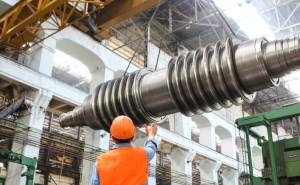The manufacturing industry has been riding the Industry 4.0 wave over the last decade, bringing various technologies to the plant floors. This fourth industrial revolution has been all about digital technologies and smart manufacturing systems. These technologies aim to improve productivity to a great extent by reducing unplanned downtime and simplifying processes. A central part of these systems that allows them to function is the Internet of Things — IoT.

- Image Credit: Aleksandar Littlewolf; Freepik
Industrial IoT
Industrial IoT (IIoT) refers to IoT used in industrial settings. IIoT is a network of various objects that transmit data to each other. IIoT is different from everyday IoT because of its applications: while the usual IoT deals with everyday tasks, IIoT works in a high-precision environment with various hazards around it. This requires using sensors of very high accuracy and robust build quality.
Another big difference between the two is the focus area. IoT is about convenience, while IIoT is about improving productivity by interconnecting assets in a production system.
Reduced downtime with PdM
Predictive maintenance (PdM) is a maintenance-scheduling technique that allocates maintenance downtime by analyzing the condition of assets in a manufacturing plant. To do this, technicians must work with interconnected, integrated systems with sensors that transfer asset data to a CMMS or EAM system. This infrastructure for transferring data across the system is IIoT.
PdM, made possible by IIoT, aims to reduce unplanned downtime to near zero. It utilizes real-time, as well as historical asset data, to calculate the optimum time for their maintenance. The downtime for maintenance helps the plant avoid breakages and unplanned downtime associated with reactive maintenance. Furthermore, since the predictive technique only suggests downtime when an asset requires maintenance, there is no need to spend resources on regular preventive maintenance.
Predictive maintenance keeps the plant running and avoids the wear and breakage of machines. In short, it’s a high-tech way of getting the best of both worlds to improve plant productivity. It also keeps all the assets in their best condition. With time and enough data for the algorithm to work on, PdM can help the plant achieve the dream of all plant managers — near-zero unplanned downtime. For any medium-sized or large plant, the advantages of using PdM — instead of reactive or preventive maintenance — usually justify investing in the software and hardware required.
Accurate asset tracking
Manufacturing plants may have thousands to even millions of assets in their inventories. Missing a plant asset can cause a chain reaction affecting multiple departments. The plant may lose valuable production hours and money searching for and replacing the faulty asset.
One good idea is to have a shared record of all assets. However, tracking every asset’s location 24/7 becomes tricky when dealing with such huge numbers.
IoT-based asset tracking is the perfect solution for any manufacturing plant dealing with extensive inventories. Multiple technologies like Bluetooth, wi-fi, and cellular networks are used for tracking assets. Their operation is based on the accuracy and range required for a specific application. To reduce capital investment, plants can use a combination of IIoT asset tracking for critical assets and barcodes for others.
One way to help your CMMS/EAM with asset location is to use IoT-based asset tracking. This can reduce asset theft and losses during transportation within the plant. In addition, the production hours saved by avoiding equipment search or replacement can lead to improvements in productivity. As IoT asset tracking provides real-time location of all assets — including the workers — the synchronization between the workers also gets better, making them more productive.
Inventory optimization
Inventory management and optimization are vital for any plant’s productivity. This involves keeping track of the available assets’ locations, prices, and reordering time. Poor inventory management can cause the plant to hold excess stock or lack raw materials and goods. Low stock means the plant isn’t meeting demand, and higher stock means the plant is wasting resources on managing inventory during low demand.
Industry 4.0 technologies like IIoT, data analytics, and AI/ML can contribute immensely to inventory management and optimization. For example, IIoT inventory tracking, combined with visualization tools in EAM/CMMS, can improve stock visibility. IIoT sensors can convey manufacturing dates, best-before dates, and other product-related information — it helps paint a clearer picture for the manager. Using this information, managers can decide which inventory to utilize first, what gets scrapped, and what to keep for a while. This improved visibility helps optimize inventory — which, in turn, keeps the plant productive and efficient.
Inventory optimization is also a part of supply chain optimization, which deals with maintaining optimum stock levels at all locations. It minimizes operating, transportation, and storage costs in the supply chain.
Safety brings productivity
You might have come across the supposition that plants must choose between safety and productivity. In reality, modern smart factories can be highly productive and have some of the safest facilities at the same time. Factory managers achieve this by using automation, IIoT, and AI solutions. IIoT connects various plant systems for monitoring production and safety. With the help of IoT, plant managers can get all the information into one place. They can then make significant decisions related to production and make real-time changes in case of an incident.
Gear sensors that track workers’ movement improve staff safety inside the plant. The sensors can warn workers they’re entering a high-risk area. Technicians can also program machines to turn themselves off when they detect humans in unsafe regions around them.
A safer workplace, with fewer incidents and injuries, can focus on productivity. Workers also improve productivity more if they don’t have to worry about unsafe work conditions.
IIoT with Big Data
IIoT creates interconnected systems spanning entire plants — sometimes even connecting multiple plants. Such massive digital infrastructure ensures that assets generate vast amounts of data at all times. Unfortunately, most of this big data goes unused, which is a significant loss for the plant. On the other hand, the data holds valuable insights into the production system, which can help improve the efficiency and productivity of the plant.
IIoT collects data from inventory and supply chain management. This data can be used to forecast demand and calculate optimum inventory levels. In addition, engineers can identify and remove disruptions to improve productivity by analyzing data from different parts of the production system.
Furthermore, predictive maintenance software can provide data about the efficiency of different assets over time. This helps get the most out of all assets; it also helps with making an informed decision about replacing or upgrading an asset. Data is gold for any industry today, and manufacturing plants must get the most out of the data they produce to stay competitive.
IoT has become a central part of production systems during the fourth industrial revolution. The future of manufacturing is in interconnected production systems that communicate using IIoT. With time, technology will only become a bigger factor in the industry and people’s everyday lives. In the long run, the manufacturers on the bandwagon have a higher chance of staying competitive in the market.
Featured Image Credit: Kateryna Babaiev; Pexels.com; Thank you!
The post How IoT Benefits Productivity on the Plant Floor appeared first on ReadWrite.


Comentarios recientes